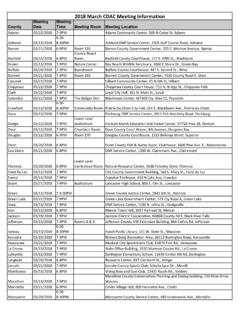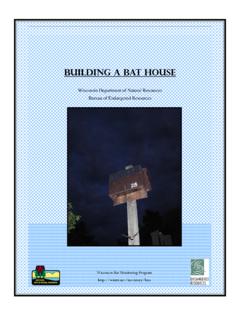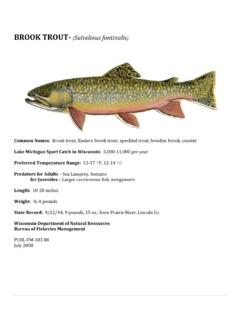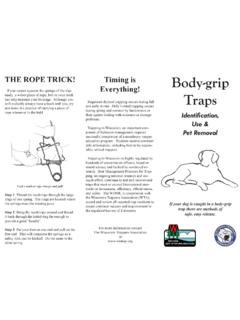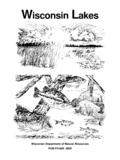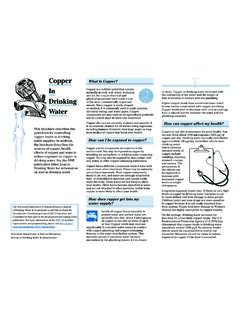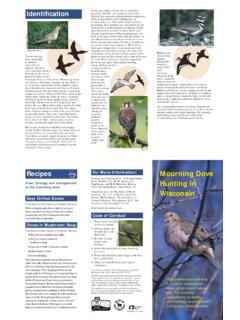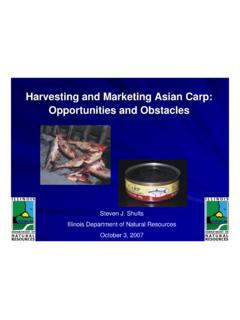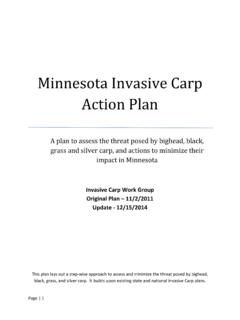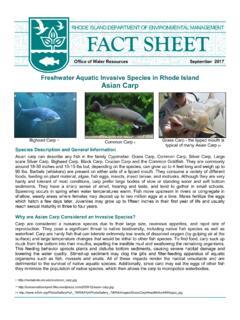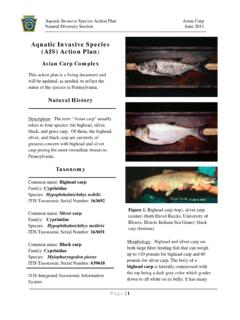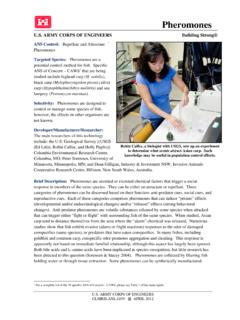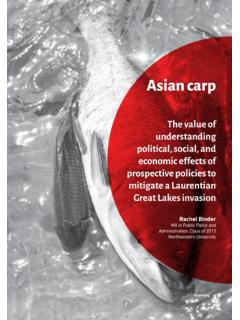Transcription of Asian Carp - Wisconsin Department of Natural Resources
1 Fish & Wildlife Service5600 American Blvd. WestBloomington, MN 55437-1458 Phone: 1-612-713-5360 Special Agent in Charge/Midwest RegionOffice of Law Enforcement 1-612-713 5320 People with hearing impairments may reach the Office of Law Enforcement through the Federal Relay System at Fish & Wildlife 2013 Silver carp (left), Bighead carp (right)USFWS photoLaws affecting the interstate movement of live Asian carp The federal government regulates the interstate movement of all live federally listed injurious invasive species under the Lacey Act, 18 USC 42, and 18 USC 3372.
2 It is a violation of federal law to transport live Asian carp in interstate addition, Wisconsin law makes it illegal to possess, transport, transfer or introduce any species of live Asian : Fish & Wildlife Service at 1-920-866-1750 or the Wisconsin DNR at should I do if I find a live Asian carp?1. If caught, do not return the fish to the Report the find to your local DNR office. If possible, it is important to provide a means of identification: Take a picture of the fish. The best angle is of the fish laid out flat. Try to include the whole fish, nose to tail, in the photo.
3 Put the fish on ice and bring it to your local DNR year thousands of pounds of live Asian carp are illegally transported across state lines in the Please do not trade in, transport, or purchase illegally traded live Asian carp. If you are aware of any of these activities occurring with live Asian carp, please call the Fish and Wildlife Service or the Wisconsin DNR Violation Hotline at 1-800-TIP-WDNR. With your help, we can stop the spread of these invasive Carp:Keep invasive species out of WisconsinKeep invasive species out of WisconsinWhat can I do to prevent Asian carp from entering Wisconsin ?
4 Learn the features that distinguish young Asian carp from gizzard shad and other native minnows, and adult fish from common carp, a related invasive carp species that has been established in Wisconsin for more than a century. Carry an Asian Carp Watch Card in your boat or tackle box. (To order watch cards or other aquatic invasive publications, send an e-mail to shad adult often a valuable fish for wildlife foodSilver carp juvenileBighead carp juvenileFollow all state rules to prevent the spread of aquatic invasive species and fish disease: INSPECT your boat, trailer, and equipment.)
5 REMOVE any attached aquatic plants or animals (before launching, after loading, and before transporting on a public highway) DRAIN all water from boats, motors and all equipment including livewells and buckets. NEVER MOVE live fish away from a waterbody. DISPOSE of unwanted bait in the trash. Buy minnows from a Wisconsin bait dealer. Use leftover minnows only under certain conditions: You may take leftover minnows away from any state water and use them again on that same water. You may use leftover minnows on other waters only if no lake or river water or other fish were added to their Department of Natural Resources101 S.
6 Weber StreetPO Box 7921 Madison, WI 53703-7921 General Information: 1-888-936-7463 Report a violation: PUB-WT-999 Asian Carp: Keep invasive species out of WisconsinThe Wisconsin Department of Natural Resources provides equal opportunity in its employment programs, services and functions, under an Affirmative Action Plan. If you have any questions, please write to Equal Opportunity Office, Department of Interior, Washington, 20240. This publication is available in alternative format (large print, Braille, audiotape etc.) upon request. Please call 608/267-7494 for more ON RECYCLED PAPERHow to identify carpFor more tips on how to identify bighead and silver carp using grass carp and common carp as points of comparison, watch the video How to Identify Asian carp (left) and Bighead carp (right).
7 A conservation officer checks for Asian of Asian carpBody silvery, often with large, dark blotches (not shown) on the back and sidesLow-seteyesUpturnedmouthBighead carplength up to 44 inchesUSFWS photoSilver carplength up to 41 inchesUSFWS photoGrass carplength up to 49 inchesUSFWS photoBlack carplength up to 48 inchesphoto by Rob Cosgriff Illinois Natural History SurveyUSFWS photoThe Asian carp threatThere are four species of Asian carp that are considered invasive and a threat to Wisconsin waters: the bighead, silver, grass and black carp. As of spring 2013, no breeding populations of these species have been found in Wisconsin or bordering waters.
8 Species of live Asian carp, including bighead and silver, are being lawfully raised in fish farms in states like Arkansas and Mississippi and commercially fished in infested waters to control their numbers. When dead, these fish pose no threat to the , when alive, these carp pose significant threats to freshwater ecosys-tems. Currently, millions of dollars are being spent to stop Asian carp before they get to the Great Lakes and other fresh-water ecosystems. Recent law enforcement activities have demonstrated that shipments of live Asian carp are being unlawfully transported across the United States, destined for fresh fish markets, in violation of federal and state are Asian carp considered injurious invasive species?
9 Asian carp grow quickly. Commonly they are found to weigh between 10 to 40 pounds, but can grow to be more than 100 pounds. Bighead and silver carp are voracious eaters capable of eating 5 to 20 percent of their body weight in plankton each day, outcompeting desirable gamefish. Black carp consume primarily mollusks, which threatens native mussel and sturgeon populations. Grass carp eliminate plant beds that provide critical habitat for young game fish and carp, sometimes referred to as jumping carp, are also a health hazard to recreational boaters.
10 When agitated by the sounds of boat motors, silver carp can jump out of the water and become potentially dangerous projectiles. Silver and Bighead carp are at risk of being imported for food, and Grass carp for vegetation control. Very tiny scales (trout like) Broad, blunt head Silver scales with prominent dark edge give cross-hatched effectBody has dark olive shading, brownish-yellow sides and white bellySilver but sometimes bronze to red sidesDark-edged scales give cross-hatched effectBlackish-brown to dark olive bodyBlackish finsWhite bellyLow-seteyesUpturnedmouthVery tiny scales (trout like)Horizontal mouth, underslung jawHorizontal mouth, underslung jaw Broad, blunt head Keel (a ridge on the bottom of the fish)

